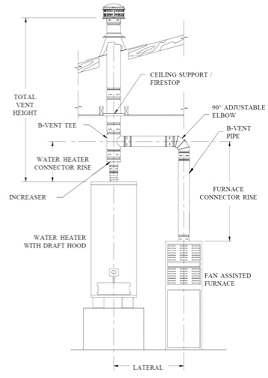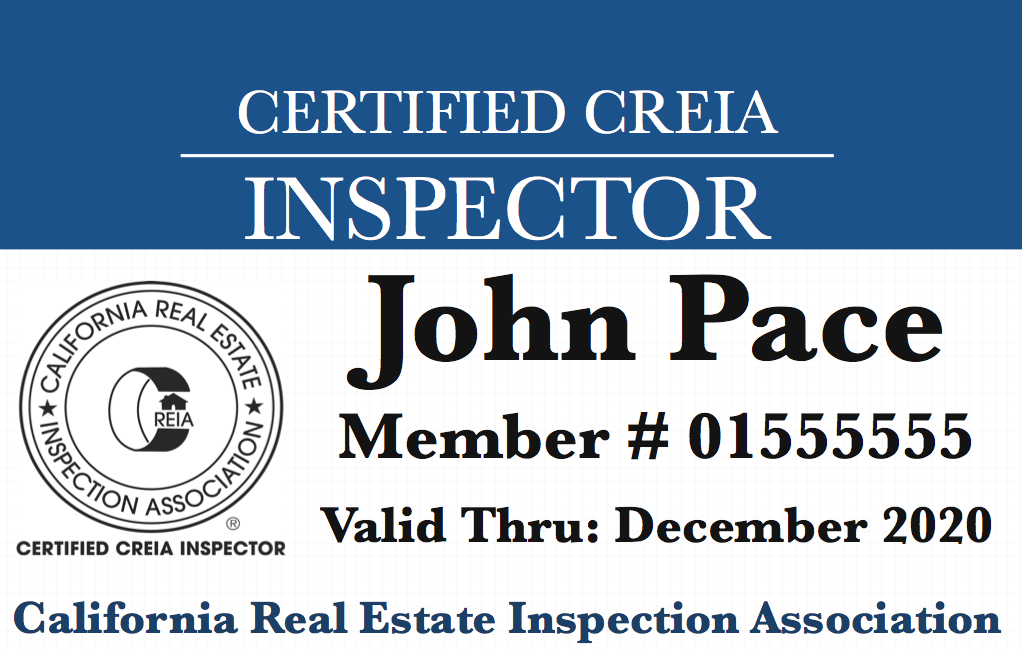Common Venting of Gas Appliances
by Michael Casey and Barry Stone
Over the years we have received many questions regarding combined venting of furnaces and water heaters. The main concern has been whether a gravity vented water heater flue can be connected to the fan-assisted flue of a Plus 80 (AFUE rated) forced air furnace. A common misunderstanding of the Uniform Mechanical Code, Section 802.3.4.4, has led many inspectors to conclude that this is a prohibited connection. The code states as follows: “Vent connectors serving appliances vented by natural draft shall not be connected into any portion of mechanical draft systems operating under positive pressure.” At first glance, this appears to include all forced air furnaces with fan-assisted combustion systems. That conclusion has led many inspectors to make faulty disclosures in their reports. The purpose of this article, therefore, is to explain the meaning and intent of the pertinent UMC requirement and to clarify when vent systems can and cannot be installed in common.
To understand the venting requirements for forced air heating equipment, a knowledge of the four vent categories of gas appliances is essential. These can be found in the National Fuel Gas Code and ANSI Z223.1, Z21.47, Z21.10.3 and Z21.13.
| Appliance Category |
Vent Pressure |
Condensing or Non-Condensing? |
Common Flue Pipe Material |
| I |
Non-Positive |
Non |
B-Vent |
| II |
Non-Positive |
Condensing |
Special per Manufacturer |
| III |
Positive |
Non |
Stainless Steel |
| IV |
Positive |
Condensing |
Plastic |
Figure 1, Table of Gas Appliance Vent Categories by the Authors

Figure 2, Typical Fan Assist Category I Furnace
Category I Furnaces are the type most commonly used for residential heating. They include old-fashioned gravity vent furnaces and the newer fan-assisted Plus 80 models, also known as induced draft furnaces. In a gravity vented furnace, the heat of combustion provides sufficient stack effect to enable safe venting of combustion byproducts. Stack effect occurs because the hot gases inside the flue have lower density that the cooler atmosphere outside the flue.
A Plus 80 furnace is designed for greater fuel efficiency than a standard gravity vented furnace. This is achieved by lengthening the heat exchanger to allow more heat transfer into the circulating air. But longer heat exchangers produce draft resistance and they lower the temperature of the exhaust gases relative to atmospheric temperature. To enable proper venting, an inducer fan is built into the system. The fan applies a slight negative pressure on the heat exchanger to ensure that the products of combustion are evacuated upward. The fan, however, does not exert positive pressure into the flue pipe. The exhaust in the flue is gravity-vented. Therefore, its vent pressure is rated as “non-positive,” which is why it can be vented in common with a gravity vented water heater.
Category II Appliances include appliances not typical intended for residential use. Exceptions are boilers and wall vented water heaters. In those cases, the manufacturers’ specifications prohibit interconnection of the exhaust systems with other gas-burning appliances.
Category III Appliances in residential use are mostly tank-less water heaters that are vented through the wall with stainless steel. These appliances operate with positive vent pressure and, therefore, cannot be adjoined to a gravity-vented water heater.
Category IV Appliances are mainly high efficiency water heaters and furnaces that use plastic vent pipes. These appliances also operate with positive vent pressure and cannot share a common vent with a gravity-vented water heater.
Inspectors should not confuse fan-assisted furnaces with those that are power vented. When a gravity-vented flue is connected to a power-vented flue, back-drafting can occur at the draft diverter of the gravity flue, exposing occupants of the building to noxious gases. With a category I furnace, this is not a problem because both appliances are gravity-vented, even an induced draft furnace.
PRODUCT DESIGN
Category I Venting (Vertical Venting)
(80% Furnaces Only)
WARNING
TO PREVENT POSSIBLE PERSONAL INJURY OR DEATH DUE TO
ASPHYXIATION, NON-CONDENSING GAS FIRED WARM AIR FURNACES MUST
BE CATEGORY I VENTED. DO NOT VENT ANY OF THESE FURNACES USING
CATEGORY III VENTING.
Category I Venting is venting at a non-positive pressure. A furnace vented as Category I is considered a fan-assisted appliance and does not have to be "gas tight." NOTE: Single-Stage and Two-Stage gas furnaces with induced draft blowers draw products of combustion through a heat exchanger allowing in some instances common venting with natural draft appliances (i.e. water heaters).
Figure 3, Typical Fan Assist Category I Furnace Placard
The text box at left, taken from an induced draft furnace instructions, clearly specifies common venting with Category I vents only. Many new furnaces now arrive with stickers stating that common venting is allowed because there has been so much confusion regarding these connections.
The drawings below illustrate typical specifications for common venting of gravity vented and induced fan-vented appliances.
 
Figure 4 Courtesy Simpson Dura-Vent with permission - Figure 5 Courtesy Simpson Dura-Vent with permission
RetroFit Venting
Another potential problem with newer Category I vents involves furnace and water heater flues that are connected to masonry chimneys. In those cases, the cold masonry cools the exhaust gases, causing loss of draft, as well as moisture condensation. The solution is to use the masonry chimney as a chase for a B-Vent.
When in doubt regarding any appliance type or installation, read the labels and, if possible, the installation manual. There are myriads of appliances in today’s marketplace with many possible alternatives for proper venting.
Michael Casey is a partner with Casey, O’Malley Associates; a national A.M. Best recommended consulting and inspector training firm based in San Diego and joint venture partner with The ASHI School. Mike is a past president of the California Real Estate Inspection Association (1994/1995) and of the American Society of Home Inspectors (ASHI) (2002). He is multi-code certified by the ICC and IAPMO. He is also a licensed general, plumbing and mechanical contractor in several states and a Virginia Certified Home Inspector. Besides co-authoring several books in the Code Check series, Casey has authored many other books, has taught home and building inspection and has an expert witness practice throughout North America since 1987.
Michael can be contacted at
[email protected]
Barry Stone has practiced home inspections on the Central Coast of California since 1987 where he survives his Realtor reputation as a “deal killer.” He is an ICC certified building inspector and mechanical inspector and an AHERA certified asbestos inspector. Stone writes the nationally syndicated column “Ask the Inspector” and authored the book “The Consumer Advocates Guide to Home Inspection.”
Barry can be contacted at
[email protected]
|





